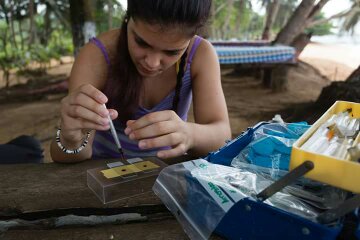How is the accumulation of metals in Green Turtles affecting the quality of their eggs?
Recently published in the scientific journal Science of The Total Environment, the article ‘Metal accumulation in female green sea turtles (Chelonia mydas) from Eastern Atlantic affects their egg quality with potential implications for embryonic development’ aims to investigate whether the metals and metalloids present in the blood of green sea turtles affect the characteristics of their eggs and the quality of their energy reserves for embryonic development.
Inês Mourão, a researcher at MARE and first author of the article, explains that ‘This work is part of my PhD, in which we sought to understand the effects of marine pollution on nesting sea turtles in the São Tomé and Príncipe archipelago. This article follows on from my previous PhD study, in which we identified that female green turtles (Chelonia mydas) were accumulating high levels of metals in their organisms. Following on from the previous study, we investigated the possible effects of metal contamination on these same females and their eggs.’

This article, which also involved our researchers Tiago Simões, Marco Lemos and Sara Novais, showed that there is a correlation between copper and mercury levels and nuclear abnormalities in red blood cells, and between copper and arsenic levels and a decrease in eggshell thickness. ‘The main results showed that female green turtles had levels of metals associated with genotoxic effects on erythrocytes. In addition, metal contamination was linked to a decrease in the thickness of the shell of their eggs. We also observed changes in the fatty acid profile of the eggs, with omega-3 fatty acids being the most negatively impacted, which could jeopardise normal embryonic development,’ explained Inês Mourão.
This study has international partnerships such as IQOG-CSIC in Madrid and the University of Siena, as well as the NGOs Associação Programa Tatô on the island of São Tomé and Fundação Príncipe with the Protetuga project on the island of Príncipe.
To access the article click HERE
Photographs by José Carlos Bernardo Costa
